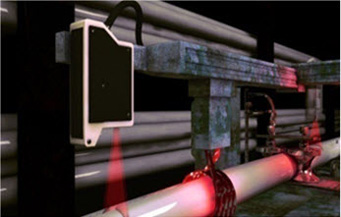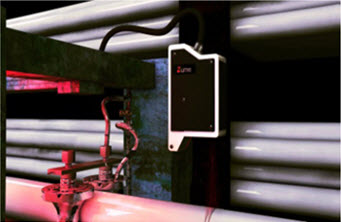Increasing the Efficiency on ERW/HFI Tube Mills: Part Two
by Pierre Huot, Vice President, Xiris Automation Inc.
Abstract
This article describes possible weld faults and causes for customers’ rejections and noncompliance, and technical details of non-contact optical measurement, as an in-process solution for these problems.
Weld Faults
It would be near impossible to pinpoint the main cause for weld faults. Nevertheless it is generally agreed that weld faults may be caused by these factors:
- Vee forming angle
- Welding speed
- Welding power
- Squeeze force
- Frequency.
All things considered, if clean smooth edges are presented to the welder in the right fashion, then the operator need only worry about running too hot or too cold.
Customer Rejection – Non Compliance
The ERW/HFI industry is a market with low switching costs. An unsatisfied client has options to find alternative suppliers in a reasonably short period of time. A company on the receiving end of an irate customer who has tube material with seam burst in process or in the field can lead to liability risks, an increase in time and money for quality managers site visits, reporting expenses and not to mention the costly time requirement of senior management to contain the problem and reassure the client. Built into the brand equity of finished product are the integrity, performance and quality that tube clients require.
The Solution: Non Contact Optical Measurement
With the multitude of things that may, can, will go wrong, and possibly happening in unison, where can an optical system provide value? The answer to that question lies in where the critical area is. The two main challenges are controlling the strip and presenting the edge precisely through the squeeze box and precise temperature control. Designed to assist the operator during setup and in process, a non contact measurement device offers assistance as a technology enabler to a path of increased efficiency, higher yield and improved bottom line profit.
Placing an optical measurement device in the infeed Vee forming area acts as a tool during:
Setup:
- Align the last fin pass and squeeze roller bottom angle.
- Align the forming rollers for proper edge presentation and Vee angle.
In process:
- Measure the Vee angle and gap values in the Vee.
- Predict the apex point relative to the weld pressure point.
- Measure the mismatch between the two strip edges.
- Measure the edge presentation.
- Measure the seam roll from centerline.
Placing an optical measurement device on the outfeed of the weld box acts as a tool during:
Setup-
- Align the weld squeeze rollers.
- Set the welding parameters to the welding speed by measuring bead geometry as an indicator of temperature for no weld, cold weld to popouts.
In process-
- Measure the bead geometry for temperature control.
- Measure the bead centerline peak.
- Measure the mismatch between the side walls.
- Measure for weld skips, gaps, defects.
- In process the measurements will stack against a set of threshold values for lower limit, warning limit, set point and upper limit.
- To ensure precise control data measurements in the realm of 50μm (0.002”) and 100μm (0.004”) are required with an interval spacing between data of 10mm (3/8”) or less.


Figure 3: a-Infeed Optical measurements b- Outfeed Optical measurement
Quality Control (SPC)
Having an inline measurement system provides an added benefit of logging the measurement data and outputting to data charts, histograms, scatter diagrams, time stamp diagrams, control charts. With this in hand the quality manager and improvement manager can gain insight into the material flow through the mill and tune the setup and process parameters to improve efficiency and yield.
Non-contact optical measurement devices offer these benefits to tube and pipe producers:
- Improves Setup time: Measuring the infeed forming will provide a faster determination of where the parameters need to be. This will in turn provide faster adjustment to the set point values.
- Increases mill efficiency: Assist controlling the Vee angle and presentation for better fusion in the weld box.
- Decreases Waste: The operator can reduce the time it takes to set the mill for forming and temperature this will reduce the amount un-welded material and rethreading.
- Decreases Scrap: Altering the operator of a potential problem ahead of the actual problem occurring means a quick response for corrective action.
- Improves Yield: Real time monitoring for early detection can improve the $ton/hr throughput.
- Enables process SPC: QC and QA can gain added analysis and reporting for internal process improvement and external client assurance.
- Increases Reliability: In a highly competitive market, protecting and building brand equity through consistent performance and quality.
- Responds to Environment: Raw material conservation and energy audits are today’s reality. Producing the same throughput with less tonnage and energy is not only profitable, but responsible.
What to Look For in an Optical Measurement Provider
Optical Know how: It starts with the quality of the acquired image. Garbage in-garbage out applies here as well. Look for a company that has in-house optical design capabilities; this greatly increases the accuracy with overburdening the cost.
Reputation for Performance: Reliability and repeatability are key for quality control measurement systems. You want to trust the system so find a firm that has a track record for uptime and performance.
Continuous Improvement: Look for a company that is willing to continually invest in R&D to improve their offering and upgrades so you can extract more value and advantage.
Responsive and Available: In a space where “time is money” a company that focuses their resources on a single market means quicker response and faster service.
Global Perspective: Work with a firm that has a macro global perspective. They can be brought into the organization locally, but have the experience and reach to connect with subsidiaries without hand holding.
Market Commitment: Niche market companies perform better, deliver better solutions and service the niche more appropriately. Look for the specialist versus a broad based company who allocates attention elsewhere.
Solid Database & SPC Package: A firm that is worth their salt in the field of quality control and inspection has a powerful SPC engine in their pocket to crunch through the data and build reports, don’t skimp out.
Find Instantly Thousands of Welding Materials!
Total Materia Horizon contains thousands of materials suitable for welding and electrodes, with their properties in bulk and as welded conditions.

Get a FREE test account at Total Materia Horizon and join a community of over 500,000 users from more than 120 countries.